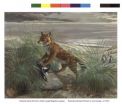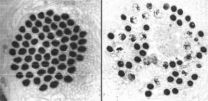(Press-News.org) University of Adelaide researchers have found the answer to one of natural history's most intriguing puzzles – the origins of the now extinct Falkland Islands wolf and how it came to be the only land-based mammal on the isolated islands – 460km from the nearest land, Argentina.
Previous theories have suggested the wolf somehow rafted on ice or vegetation, crossed via a now-submerged land bridge or was even semi-domesticated and transported by early South American humans.
The 320-year-old mystery was first recorded by early British explorers in 1690 and raised again by Charles Darwin following his encounter with the famously tame species on his Beagle voyage in 1834.
Researchers from the University's Australian Centre for Ancient DNA (ACAD) extracted tiny pieces of tissue from the skull of a specimen collected personally by Darwin. They also used samples from a previously unknown specimen, which was recently re-discovered as a stuffed exhibit in the attic of Otago Museum in New Zealand.
The findings were published in Nature Communications today and concluded that, unlike earlier theories, the Falkland Islands wolf (Dusicyon australis) only became isolated about 16,000 years ago around the peak of the last glacial period.
"Previous studies used ancient DNA from museum specimens to suggest that the Falkland Islands wolf diverged genetically from its closest living relative, the South American maned wolf (Chrysocyon brachyurus) around seven million years ago. As a result, they estimated that the wolf colonised the islands about 330,000 years ago by unknown means," says Associate Professor Jeremy Austin, Deputy Director of ACAD and co-lead author with Dr Julien Soubrier.
"Critically, however, these early studies hadn't included an extinct relative from the mainland, the fox-like Dusicyon avus. We extracted ancient DNA from six specimens of D. avus collected across Argentina and Chile, and made comparisons with a wide group of extinct and living species in the same family."
ACAD's analyses showed that D. avus was the closest relative of the Falkland Islands wolf and they separated only 16,000 years ago – but the question of how the island colonisation came about remained. The absence of other mammals argued against any land bridge connection to the mainland.
"The Eureka moment was finding evidence of submarine terraces off the coast of Argentina," says study leader Professor Alan Cooper. "They recorded the dramatically lowered sea levels during the Last Glacial Maximum (around 25-18,000 years ago)."
"At that time, there was a shallow and narrow (around 20km) strait between the islands and the mainland, allowing the Falkland Islands wolf to cross when the sea was frozen over, probably while pursuing marine prey like seals or penguins. Other small mammals like rats weren't able to cross the ice."
INFORMATION:
Photo caption: Painting of a Falkland Islands wolf by Michael Rothman, Ace Coinage Inc
Media Contact:
Professor Alan Cooper
Director, Australian Centre for Ancient DNA
The University of Adelaide
Phone: +61 8 8313 3952
Mobile: +61 406 383 884
alan.cooper@adelaide.edu.au
Associate Professor Jeremy Austin
Deputy Director, Australian Centre for Ancient DNA
The University of Adelaide
Phone: +61 8 8313 4557
Mobile: +61 404 198 493
jeremy.austin@adelaide.edu.au
Robyn Mills
Media Officer
The University of Adelaide
Phone: +61 8 8313 6341
Mobile: +61 410 689 084
robyn.mills@adelaide.edu.au
Ancient DNA solves 320-year-old mystery
2013-03-05
ELSE PRESS RELEASES FROM THIS DATE:
Mental picture of others can be seen using fMRI, finds new study
2013-03-05
ITHACA, N.Y. – It is possible to tell who a person is thinking about by analyzing images of his or her brain. Our mental models of people produce unique patterns of brain activation, which can be detected using advanced imaging techniques according to a study by Cornell University neuroscientist Nathan Spreng and his colleagues.
"When we looked at our data, we were shocked that we could successfully decode who our participants were thinking about based on their brain activity," said Spreng, assistant professor of human development in Cornell's College of Human Ecology.
Understanding ...
Children of divorced parents more likely to switch, pull away from religions, Baylor study finds
2013-03-05
Adults whose parents were divorced are more likely to switch religions or disassociate themselves from institutional religions altogether — but growing up in a single-parent family does not have any effect on private religious life, including praying, according to a study by a Baylor University sociologist.
The findings also suggest that being a child of divorced parents is not in itself as important a factor in a person's religious life as previous research has indicated, according to Jeremy Uecker, Ph.D., an assistant professor of sociology in Baylor's College of Arts ...
Parents, religion guard against college drinking
2013-03-05
EAST LANSING, Mich. — Religious college students report less alcohol use than their classmates – and the reason may have to do with how their parents handle stress, according to new research by a Michigan State University scholar.
The study found that students who used religious practices such as praying and meditating as a coping mechanism reported less frequent alcohol use and less heavy drinking.
Further, the parents of those students reported using religious or spiritual practices when facing stress, which was linked to the behaviors reported by the students. This ...
USF and KAUST chemists develop efficient material for carbon capture
2013-03-05
TAMPA, Fla. (March 5, 2013) – Chemists at the University of South Florida and King Abdullah University of Science and Technology have discovered a more efficient, less expensive and reusable material for carbon dioxide (CO2) capture and separation. The breakthrough could have implications for a new generation of clean-air technologies and offers new tools for confronting the world's challenges in controlling carbon.
Publishing this month in the journal Nature, the international group of scientists has identified a previously underused material – known as SIFSIX-1-Cu - ...
Gravitational telescope creates space invader mirage
2013-03-05
Abell 68, pictured here in infrared light, is one of these galaxy clusters, and it greatly boosts the power of Hubble, extending the telescope's ability to observe distant and faint objects [1]. The fuzzy collection of blobs in the middle and upper left of the image is a swarm of galaxies, each with hundreds of billions of stars and vast amounts of dark matter.
The effect of this huge concentration of matter is to deform the fabric of spacetime, which in turn distorts the path that light takes when it travels through the cluster. For galaxies that are even further away ...
Health benefits of marriage may not extend to all
2013-03-05
COLUMBUS, Ohio – Marriage may not always be as beneficial to health as experts have led us to believe, according to a new study.
Researchers made two discoveries that explain why: First, marriage provides less protection against mortality as health deteriorates, even though it does seem to benefit those who are in excellent health. Secondly, married people tend to overestimate how healthy they are, compared to others.
"We believe marriage is still good for the health of some people, but it is not equally protective for everyone," said Hui Zheng, lead author of the study ...
Heavy moms-to-be at greater risk of c-section
2013-03-05
Researchers from Norway found that women with a pre-pregnancy body mass index (BMI) of 40 had an increased risk of vacuum extraction delivery or Cesarean section (C-section). Findings that appear in Acta Obstetricia et Gynecologica Scandinavica, a journal published by Wiley on behalf of the Nordic Federation of Societies of Obstetrics and Gynecology, indicate that women with more than a 16 kg (30 lbs) weight gain during pregnancy increased their risk of forceps or vacuum extraction, and C-section.
Obesity is a global health crisis, with the World Health Organization ...
Why fish is so good for you
2013-03-05
Jena (Germany) Fish is healthy: easy to digest and with a high level of precious proteins, fish is considered an important part of a healthy diet. And with the so-called omega-3 fatty acids fish contains real 'fountains of youth'. These fatty acids – like docosahexaeonic acid (DHA) occur mostly in fatty fish like herring, salmon and mackerel. They are thought to lower the blood pressure, to strengthen the immune system and to have positive effects on the development on the nervous system and the cardiovascular system.
"Clinical studies about the intake of nutritional ...
Does the villainous 'selfish' gene undermine genome's police?
2013-03-05
PROVIDENCE, R.I. [Brown University] — For a bunch of inanimate chemical compounds, the nucleic and amino acids caught up in the infamous "selfish" segregation distorter (SD) saga have put on quite a soap opera for biologists since the phenomenon was discovered in fruit flies 50 years ago. A new study, a highlight in the March issue of the journal Genetics, provides the latest plot twist.
In TV listings the series would be described this way: "A gene exploits a rival gene's excesses, sabotaging any sperm that bear the rival's chromosome." The listing is not an exaggeration ...
Colonoscopy screening reduces risk of advanced colorectal cancer
2013-03-05
Philadelphia - A new study led by a researcher at the Perelman School of Medicine at the University of Pennsylvania adds support to current medical recommendations stating that screening colonoscopy substantially reduces an average-risk adult’s likelihood of being diagnosed with advanced colorectal cancer (CRC) in either the right or left side of the colon. In recent years, colonoscopy has begun to rapidly replace sigmoidoscopy – a procedure used to detect abnormalities in the rectum and left side of the colon – despite initially limited evidence of its efficacy and higher ...




